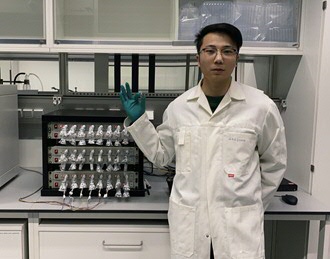Advent calendar - December 6th - Yongsheng Zhang
In the Zernike Institute Advent Calendar, we are presenting 24 short spotlights in December. In these specials, we highlight PhD students, postdocs, support staff and technicians of our research groups and team - providing a glimpse in their typical day at work. In Episode 6 meet Yongsheng Zhang, PhD candidate in the Physical Chemistry of Polymeric and Nanostructured Materials group.

I am Yongsheng, a Ph.D. candidate at the University of Groningen and part of the Physical Chemistry of Polymeric and Nanostructured Materials group under the supervision of prof. Giuseppe Portale. My research focuses on creating novel self-healing supramolecular polymers to improve the performance and safety of lithium metal batteries.
Why lithium metal batteries? While lithium-ion batteries dominate today's market, powering our smartphones and electric vehicles, they fall short in energy density and capacity. Ever wondered why your phone’s battery dies halfway through the day or your electric car needs frequent recharging? That’s where lithium metal batteries come in—they promise much higher capacity and longer-lasting power. Why self-healing polymers? Polymers are cost-effective and easy to produce, making them ideal for large-scale applications. Adding self-healing properties to them takes these materials a step further—enabling batteries to repair damage, improve lifespan, and maintain performance over time.
Where can we use self-healing polymer in the battery? A battery comprises three main parts: electrodes, electrolyte, and separator. My research spans all these areas. To enhance safety, I’m replacing traditional liquid electrolytes with self-healing solid polymer electrolytes, which could reduce the risk of leaks and fires. Lithium metal anodes, while highly promising, suffer from capacity decay over time. To counter this, I research to developed protective polymer layers that minimizes degradation and improves the battery's lifespan. On the other side, the separator is especially important in lithium-sulfur (Li-S) batteries. To address the so-called “shuttle effect," which reduces efficiency and cycle life, I work on developing a simple yet effective coating that leverages electrostatic interactions to suppress this issue.
It’s easy to think lab discoveries are far removed from everyday life—until you see their impact firsthand. One winter, I used a coin cell with a solid polymer electrolyte I assembled to power my bike lamp. To my surprise, that tiny battery lasted the entire season without needing a recharge. Moments like these remind me why I love my work as a researcher—turning innovative ideas from the lab into real-world solutions that can truly change how we live.
More news
-
15 September 2025
Successful visit to the UG by Rector of Institut Teknologi Bandung
